|
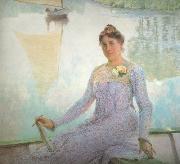 |
Emile Claus
|
|
Belgian Painter, 1849-1924
Belgian painter. He had various menial jobs before the composer Peter Benoet persuaded his father to let him study at the Koninklijke Academie voor Schone Kunsten in Antwerp. He was taught there by Nicaise De Keyser and Jacob Jacobs (1812-79) but found the atmosphere uncongenial and soon left. In 1879 he travelled around Spain and North Africa and in 1881 went to live with his sister at Waereghem. His painting of this period was influenced by Charles Verlat and depicted rural subjects |
 |
emil osterman
|
|
male model and pupils. ca. 1892
royal academy of fine arts |
 |
Emil Orlik
|
|
(July 21, 1870 - September 28, 1932) was born in Prague, which was at that time part of the Austro-Hungarian Empire, and lived and worked in Prague, Austria and Germany. He was a painter, an etcher and lithographer.
In 1905 Emil Orlik moved to Berlin and took a post at the "School for Graphic and Book Art" of the Museum of Decorative Arts (Kunstgewerbemuseum), now part of the Berlin State Museums.
|
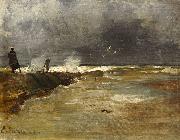 |
Emil Neumann
|
|
painted Strandspaziergang bei Wellengang in 1890 |
 |
Emil Lindgren
|
|
painted Interior med musicerande kvinnor vid pianot in 1893 |
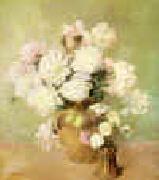 |
Emil Carlsen
|
|
Danish-born American Painter, 1853-1932
Soren Emil Carlsen (1853 ?C 1932) was an American painter associated with the Cos Cob Art Colony.
Carlsen painted primarily landscapes and still lifes. His fastidiously painted still lifes are influenced by Chardin and often depict copper pans, game, or flowers. He was an art teacher for over fifty years; his students included James Swinnerton. |
|
|
Emil Barentzen
|
|
Emilius Ditlev Bærentzen, usually known as Emil Barentzen, (30 October 1799, Copenhagen - 14 February 1868, Copenhagen) was a Danish portrait painter and lithographer, active during the Golden Age of Danish Painting.
Born in Copenhagen on 30 October 1799, Barentzen served an apprenticeship at the pharmacy in Nykobing Sjælland but then travelled to Christiansted on the then Danish island of St. Croix in the West Indies where he worked in one of the government offices. Five years later he returned to Denmark and, after qualifying as a lawyer, moved into painting which until then he had practiced as a hobby. In 1821, he entered the Danish Academy where he studied under Christoffer Wilhelm Eckersberg. He was awarded the little silver medal in 1826 and the large silver medal the following year. He soon became one of Copenhagen's most popular portrait painters. His paintings were characterized by an elegant but sober style, free of psychological trimmings in accordance with contemporary practice. One of his most successful works is the portrait of Soren Kirkegaard's fiancee Regine Olsen (1840).
In 1837, he began to specialize in lithography with H.L. Danschell who managed his deceased father-in-law's oilcloth factory where stones were used to colour the fabric. This led to the founding of a lithographic company, Emilius Bärentzen & Co.s litografiske Institut, which later became Hoffensberg, Jespersen & Fr. Trap. Bærentzen made lithographs of many of the period's most important figures. He continued to work both as a lithographer and artist until 1866 when he painted the portraint of Cosmus Bræstrup for the Freemasons lodge in Helsingor. He died on 14 February 1868. |
 |
Emanuel Leutze
|
|
historical painter, born in Gmund, Wurtemberg, 24 May, 1816; died in Washington, DC 18 July, 1868.American painter of German birth. When he was nine, Leutze's family emigrated to America and settled in Philadelphia. In 1834 he began to study art with the draughtsman John Rubens Smith (1775-1849). Leutze developed his skills as a portrait painter by taking likenesses to be engraved for publication in the National Portrait Gallery of Distinguished Americans and then working as an itinerant painter. He also experimented with imaginative compositions, such as the Poet's Dream (Philadelphia, PA Acad. F.A.). Philadelphia patrons sponsored his study in Europe, and in 1841 he enrolled at the Kenigliche Kunstakademie in Desseldorf. Although attempts at history painting won approval in Germany and in the USA, Leutze left the academy in 1843. He travelled for two years in Germany and Italy, during which time he became convinced of the importance of freedom and democracy, |
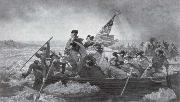 |
Emanuel Gottlieb Leutze
|
|
German-born American Romantic Painter, 1816-1868,American painter of German birth. When he was nine, Leutze's family emigrated to America and settled in Philadelphia. In 1834 he began to study art with the draughtsman John Rubens Smith (1775-1849). Leutze developed his skills as a portrait painter by taking likenesses to be engraved for publication in the National Portrait Gallery of Distinguished Americans and then working as an itinerant painter. He also experimented with imaginative compositions, such as the Poet's Dream (Philadelphia, PA Acad. F.A.). Philadelphia patrons sponsored his study in Europe, and in 1841 he enrolled at the K?nigliche Kunstakademie in Desseldorf. Although attempts at history painting won approval in Germany and in the USA, Leutze left the academy in 1843. He travelled for two years in Germany and Italy, during which time he became convinced of the importance of freedom and democracy, which he believed to be fundamental institutions of the American political system. |
 |
Emanuel de Witte
|
|
(1617 - 1692) was a Dutch perspective painter. In contrast to Pieter Jansz Saenredam, who emphasized architectural accuracy, De Witte was more concerned with the atmosphere of his interiors. Though few in number, de Witte also produced genre paintings.
De Witte was born in Alkmaar and learned geometry from his father, a schoolmaster. He joined the local Guild of St Luke in 1636. After a stay in Rotterdam, he moved to Delft and studied with Evert van Aelst. In 1651 de Witte settled in Amsterdam where his first wife, Geerje Arents, died in 1655. He then married a 23-year-old orphan, Lysbeth van der Plas, who exercised a bad influence on de Witte's adolescent daughter. In December 1659 both were arrested for theft from a neighbor.Lysbeth, pregnant, had to leave the city for a period of six years; she lived outside the city walls and died in 1663.
Following the arrest of his wife and child, de Witte was forced to indenture himself to the Amsterdam notary and art dealer Joris de Wijs, surrendering all of his work in exchange for room, board, and 800 guilders annually. De Witte broke the contract, was sued by the dealer, and forced to indenture himself further as a result. Several patrons provided de Witte with support, but these relations did not work out well, for he tended to shout at his clients and at people watching him at work in churches. Records tell of his gambling habit and a fight with Gerard de Lairesse. According to Arnold Houbraken, after an argument about the rent, de Witte hanged himself from a canal bridge in 1692. The rope broke and de Witte drowned. Because the canal froze that night, his corpse was not found until eleven weeks later
|
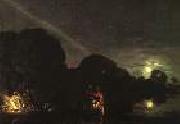 |
ELSHEIMER, Adam
|
|
German Baroque Era Painter, 1578-1610
German painter, printmaker and draughtsman, active in Italy. His small paintings on copper established him after his brief life as the most singular and influential German artist to follow D?rer. Their grand conception in terms of monumental figures and poetic landscape and their meticulous, miniature-like execution were admired by Rubens and came to influence many 17th-century artists, including Rembrandt. Most were produced in Rome after 1600:
|
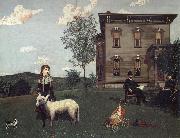 |
Elmer Edwin Romanzo
|
|
Portrait, genre and still life painter
b.1850 d.1923
was an American portrait, genre and still life painter. Known for his attention to detail, he was also an inventor of a machine for braiding horsewhips. Spending most of his life in Ashfield, Massachusetts, Elmer is best known for his painting Mourning Picture. This 1890 family portrait depicts the artist, his wife, and their daughter Effie who had died shortly before it was painted. The painting is noted for its intricate detail and the contrast between the mourning family, who sits in relative darkness, and the dead daughter, who is bathed in sunlight. It was first displayed in a local post office in 1890, then disappeared until the 1950's. |
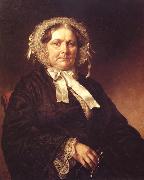 |
Elliott Charles Loring
|
|
born in Scipio, New York, in December 1812; died in Albany, NY., 25 Sept., 1868.
died in Albany, NY., 25 Sept., 1868., American painter. Resolved to become an artist, he moved from Syracuse, NY, to New York City around 1830, bearing a letter of introduction to John Trumbull and reportedly receiving some brief instruction from him. Elliott spent six months in the studio of the genre painter John Quidor but returned to upstate New York, where he worked for several years as an itinerant portrait painter. Back in New York City by 1839, his art steadily improved; Henry Inman met him around 1844-5, whereupon he predicted: 'When I am gone that young man will take my place'. Elliott's portrait of Capt. John Ericsson (c. 1845; untraced) won praise in 1845 as 'the best American portrait since [Gilbert] Stuart', and from that date he was acknowledged as New York's leading portrait painter. His facility for capturing a vivid, characteristic likeness and his genial personality assured a constant stream of private patrons and public commissions. In 1867 it was reported that he had executed nearly 700 portraits. |
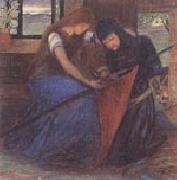 |
Elizabeth Siddal
|
|
British Pre-Raphaelite Artist , 1829-1862
was a British artists' model, poet and artist who was painted and drawn extensively by artists of the Pre-Raphaelite Brotherhood. Siddal was perhaps the most important model to sit for the Pre-Raphaelite Brotherhood. Their ideas about feminine beauty were profoundly influenced by her, or rather she personified those ideals. She was Dante Gabriel Rossetti's model par excellence; almost all of his early paintings of women are portraits of her. She was also painted by Walter Deverell, William Holman Hunt and John Everett Millais, and was the model for Millais' well known Ophelia (1852). Named Elizabeth Eleanor Siddall, after her mother, Lizzie was born on 25 July, 1829, at the family??s home at 7 Charles Street, Hatton Garden. She was born to Charles Siddall and Eleanor Evans, a family of English and Welsh descent. At the time of Lizzie??s birth, her parents were not poverty stricken. Her father had his own cutlery-making business. Around 1831, the Siddall family moved to the borough of Southwark, in south London, a less salubrious area than Hatton Garden. It was in Southwark that the rest of Lizzie??s siblings were born: Lydia, to whom Lizzie was particularly close, Mary, Clara, James and Henry. Although there is no record of her having attended school, Lizzie was able to read and write, presumably having been taught by her parents. She developed a love of poetry at a young age, after discovering a poem by Tennyson on a scrap of newspaper that had been used to wrap a pat of butter. This discovery was one of Lizzie??s inspirations to start writing her own poetry. Model for the Pre-Raphaelites Siddal, whose name was originally spelt 'Siddall' (it was Rossetti who dropped the second 'l') was first noticed by Deverell in 1849, while she was working as a milliner in Cranbourne Alley, London. She was the daughter of Charles Crooke Siddall, a cutler who claimed that his family descended from nobility, and his wife Elizabeth Eleanor Evans Siddall. Neither she nor her family had any artistic aspirations or interests. She was employed as a model by Deverell and through him was introduced to the Pre-Raphaelites. The twenty-year-old with her tall thin frame and copper hair was the first of the Pre-Raphaelite stunners. William Michael Rossetti, her brother-in-law, described her as "a most beautiful creature with an air between dignity and sweetness with something that exceeded modest self-respect and partook of disdainful reserve; tall, finely-formed with a lofty neck and regular yet somewhat uncommon features, greenish-blue unsparkling eyes, large perfect eyelids, brilliant complexion and a lavish heavy wealth of coppery golden hair. |
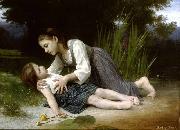 |
Elizabeth Jane Gardner
|
|
(October 4, 1837-January 28, 1922) was an American academic and salon painter, who was born in Exeter, New Hampshire. She was an American expatriate who died in Paris where she had lived most of her life. She studied in Paris under the figurative painter Hugues Merle (1823-1881), the well-known salon painter Jules Joseph Lefebvre (1836-1911), and finally under William-Adolphe Bouguereau (1825-1905). After Bouguereau's wife died, Gardner became his paramour and after the death of his mother, who bitterly opposed the union, she married him in 1896. She adopted his subjects, compositions and even his smooth facture, adopted them so successfully that some of her work might be mistaken for his. Gardner's best known work may be The Shepherd David Triumphant (1895), which shows the young shepherd with the lamb he has rescued. Among her other works were "Cinderella," "Cornelia and Her Jewels," "Corinne," "Fortune Teller," "Maud Muller," "Daphne and Chloe," "Ruth and Naomi," "The Farmer's Daughter," "The Breton Wedding," and some portraits.
|
 |
Elisabetta Sirani
|
|
(8 January 1638 -25 August 1665) was an Italian Baroque painter whose father was the painter Giovanni Andrea Sirani of the School of Bologna
She was born in Bologna. By age 17 she was a full-fledged engraver and painter and had completed over ninety works. By the time she died at the young age of 27, she had added at least eighty more to her repertoire. Besides being an independent painter by the age of 19, Elisabetta Sirani also ran her family's workshop. When her father became incapacitated by gout, she was burdened with having to support her parents, her siblings and herself, entirely through her art. The stress created by such heavy responsibilities may have been the cause of her early death. It is estimated that in all she produced some 200 paintings, drawings, and etchings. She painted themes such as the Virgin and Child, self portraits, and many more.
Elisabetta Sirani used dramatic light and great movement in her work, which classified it in the Baroque style. She painted many of her larger scale and heavy-themed works publicly and in front of large (and adoring) crowds of on-lookers. Sirani's portraits, mythological subjects, and especially her images of the Holy Family and the Virgin and Child, gained international fame. |
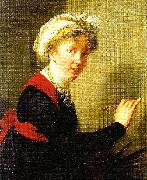 |
elisabeth vigee-lebrun
|
|
Élisabeth-Louise Vigee-Le Brun, född 16 april 1755 i Paris, död 30 mars 1842 i Louveciennes, 20 kilometer väster om Paris, var en fransk målare som i huvudsak målade porträtt.
Vigee-Lebrun utförde tilldragande, idealiserande porträtt och var för en tid hovmålare hos drottning Marie Antoinette. Vigee-Lebrun var tvungen att lämna Frankrike pågrund av den franska revolutionen 1789 och efter det var hon verksam i Ryssland, Italien och Storbritannien. Efter att Napoleons kommit till makten återvände hon till Frankrike. Hon besökte Schweiz 1807 där hon i Geneve blev invald som hedersmedlem i Societe pour l'Avancement des Beaux-Arts.
Vigee-Le Brun lämnade ett arv av 660 porträttmålningar och 200 landskapsmålningar. Dessa finns i privata samlingar i Europa och USA men även i stora museer som Eremitaget, National Gallery i London, Metropolitan Museum of Art i New York och National Gallery of Art i Washington, D.C.. |
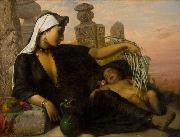 |
Elisabeth Jerichau Baumann
|
|
(born November 21, 1819 - died July 11, 1881 in Copenhagen) was a Polish-born Danish painter. She was married to the sculptor Jens Adolf Jerichau.
Elisabeth Jerichau-Baumann was born in Zoliborz (Jolibord) a borough of Warsaw.Her father Philip Adolph Baumann (1776 - 1863), a mapmaker, and her mother, Johanne Frederikke Reyer (1790 - 1854), were German.
At the age of nineteen, she began her studies in Desseldorf which at the time was one of the most important art centres in Europe and her early subject matter was drawn from Slovak life. She began exhibiting there and in 1844 attracted public attention for the first time. After she moved to Rome, her paintings were primarily of local life. It was here that she met her future husband, Jens Adolf Jerichau, whom she married in 1846. When the artist couple was not travelling, she spent many hours a day in their studio in Rome. She was particularly fond of the Italian carnival as a theme.
|
 |
Elihu Vedder
|
|
American Symbolist Painter, 1836-1923
American painter, illustrator, sculptor and writer. He studied under Tompkins Harrison Matteson in Shelbourne, NY, and went to Paris in March 1856. After eight months in the studio of Fran?ois-Edouard Picot, he settled in Florence until the end of 1860. There he learnt drawing from Raffaello Bonaiuti, became interested in the Florentine Renaissance and attended the free Accademia Galli. A more significant artistic inspiration came from the Italian artists at the Caff? Michelangiolo: Telemaco Signorini, Vincenzo Cabianca (1827-1902) and especially Nino Costa (1827-1902). This group sought new and untraditional pictorial solutions for their compositions and plein-air landscapes and were particularly interested in the experiences of Gustave Courbet and the Barbizon painters. They became known as Macchiaioli for their use of splashes (macchia) of light and shadows and for their revolutionary (maquis) attitude to prevailing styles. Among Vedder's most notable Florentine landscapes are Mugnone Torrent near Fiesole (Detroit, MI, Inst. A.) and Le Balze, Volterra (Washington, DC, N. Mus. Amer. A.) |
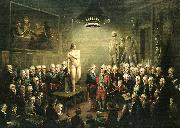 |
elias martin, gustav
|
|
Elias Martin, döpt 8 mars 1739 i Stockholm, död 25 januari 1818, svensk målare som vann internationell berömmelse under sin livstid för sina landskapsmålningar, porträtt och genremålningar, och var "associate member" av Royal Academy.
Elias Martin var son till åldermannen i snickarämbetet Olof Martin och Ulrika Haupt, syster till Georg Haupt. Han fick sin första utbildning hos fadern och visade sådan talang att han sändes till ämbetsmålaren F.C. Schultz. Genom denne fick han anställning hos Fredrik Henrik af Chapman som arkitekturritare och teckningslärare för officerarna i Sveaborg. Där fick han ledning av fältmarskalken Augustin Ehrensvärd, och umgick med och undervisade dennes son Carl August Ehrensvärd. |
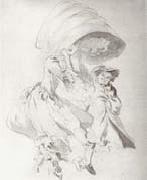 |
Elias Martin
|
|
Swedish Painter, 1739-1818,Painter and engraver. After training in his father joinery shop and with the painter Friedrich Schultz (1709-69), he was engaged to design ornamentation for ships of the coastal fleet at Sveaborg (Finland). There he also taught drawing to the son of Field Marshal Count Augustin Ehrensv?rd (1710-72) while himself learning printmaking techniques from the Field Marshal. During this period Martin produced accurate studies of Finland coastal scenery and the Sveaborg fortress (e.g. Stockholm, Nmus.), as well as purely imaginary landscapes based on engravings. In 1766 he went to Paris and with Alexander Roslin help was able to study under Joseph Vernet at the Acad?mie Royale de Peinture et de Sculpture. A direct result of his studies was a View of Paris from the Quay Beneath the Pont Neuf (1766-7; Stockholm, Nmus.). |
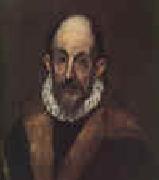 |
El Greco
|
|
Greek-born Spanish Mannerist Painter, 1541-1614
Considered a representative of late Renaissance Spanish art, El Greco was actually born in Greece, on the island of Crete. After studying in Venice under Titian, El Greco settled in Toledo, Spain in 1577. At the time he was wildly popular, his emotionally religious paintings being just the ticket for the hometown of the Spanish Inquisition. After his death his work was largely ignored until the beginning of the 20th century; now he considered one of the inspired geniuses of Western art. His distinctive style features bold shapes and colors, with elongated and slightly distorted figures.
In Toledo El Greco was in constant demand and liked living large: he maintained a private orchestra to accompany his meals. |
 |
eisabeth Vige-Lebrun
|
|
(Marie Élisabeth Louise; 16 April 1755 - 30 March 1842) was a French painter, and is recognized as the most famous female painter of the 18th century. Her style is generally considered Rococo and shows interest in the subject of neoclassical painting. Vigee Le Brun cannot be considered a pure Neoclassist, however, in that she creates mostly portraits in Neoclassical dress rather than the History painting. In her choice of color and style while serving as the portrait painter to Marie Antoinette, Vigee |
 |
Eilif Peterssen
|
|
1852-1928
was a Norwegian painter. He attended the of Fredrik Eckersberg in Kristiania (now Oslo) in 1866 and 1870. After that, he studied painting briefly with Knud Bergslien at the Johan Fredrick Eckersberg School of Painting and left to go abroad in 1871. He studied at the School of Art of Copenhagen; in Karlsruhe (1871?C1873), where he was a student of Hans Gude; and, together with Hans Heyerdahl, in Munich under Wilhelm von Diez. He then studied in London, Paris, and Italy. After these travels, he returned to Norway and settled in Bærum. He made his debut at the Høstutstillingen (Autumn Exposition) in Kristiania in 1882. He was a profound connoisseur of European art and was later associated groups such as Lysaker, the painters of Fleskum and those of Skagenpainters, as well as with individual artists like August Eiebakke, Kitty Kielland and Harald Oskar Sohlberg. In Norway, he is also known as the designer of the coat of arms of Norway, adopted when the country separated from Sweden in 1905 to become an independent country. This version was used for official government purposes until 1937, when it was replaced by a new version. Nonetheless, Peterssen's design is still used for the royal coat of arms and for the royal flag. In addition to his canvasses, he collaborated on the decoration of the Tourist Hotel in Holmenkollen in 1889. In the same year, he painted the murals "The Wanderers of Emmaus" in the Church of Tanum in Bærum and "Jesus in the Garden of Gethsemane" in the Church of the Cross, Bergen. |
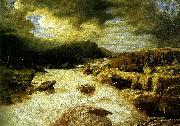 |
egron lundgren
|
|
Egron Sellif Lundgren, född 18 december 1815 i Stockholm, död 16 december 1875 i Stockholm var en svensk konstnär och författare. Hans lite egendomliga förnamn är givet av en omtänksam fader som önskade sin lille nyfödde ett rofyllt liv, eg-ron.
Egron Lundgren kan betecknas som den svenska akvarellkonstens fader. Han började först som oljemålare där han utförde genremålningar och historiska framställningar i tidens anda. Under sina många resor till Italien, Spanien och Indien fann han dock sitt rätta uttrycksmedel i akvarellen vars teknik han utvecklade till ett mästerskap. Han bosatte sig i mitten av 1850-talet i London där han hade stora framgångar som porträttmålare.
Med London som utgångspunkt företog han sedan ytterligare resor både till Italien och Spanien men även till Egypten och Indien. Hans reportagemålningar från sepoyupproret i Indien anses utgöra en av höjdpunkterna i hans produktion.
Hans akvarellteknik utvecklades med åren till en snabb, upplöst teknik i rena, klara färger och lätt penselföring.
England med sina dimhöljda öar kom till fullt uttryck i arbetena från hans många resor.
Sina sista år tillbringade Egron Lundgren i Stockholm men också därifrån fortsatte han sitt resande. Mest känd för en sentida publik har han blivit genom sina brev och dagboksanteckningar, utgivna under titeln En målares anteckningar 1 - 2
Egron Lundgrens väg i Södra Ängby, Stockholm är uppkallad efter Egron Lundgren. |
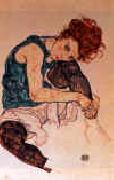 |
Egon Schiele
|
|
1890-1918
Austrian
Egon Schiele Gallery
Egon Schiele (12 June 1890 ?C 31 October 1918) was an Austrian painter, a protege of Gustav Klimt, and a major figurative painter of the early 20th century. Schiele's body of work is noted for the intensity and the large number of self-portraits he produced. The twisted body shapes and the expressive line that characterize Schiele's paintings and drawings make the artist an early exponent of Expressionism, although still strongly associated with the art nouveau movement (Jugendstil). The most important collection of Schiele's work is housed in the Leopold Museum, Vienna.
In 1907, Schiele sought out Gustav Klimt. Klimt generously mentored younger artists, and he took a particular interest in the gifted young Schiele, buying his drawings, offering to exchange them for some of his own, arranging models for him and introducing him to potential patrons. He also introduced Schiele to the Wiener Werkstätte, the arts and crafts workshop connected with the Secession. In 1908 Schiele had his first exhibition, in Klosterneuburg. Schiele left the Academy in 1909, after completing his third year, and founded the Neukunstgruppe ("New Art Group") with other dissatisfied students.
Sitzender weiblicher Akt, 1914Klimt invited Schiele to exhibit some of his work at the 1909 Vienna Kunstschau, where he encountered the work of Edvard Munch, Jan Toorop, and Vincent van Gogh among others. Once free of the constraints of the Academy's conventions, Schiele began to explore not only the human form, but also human sexuality. At the time, many found the explicitness of his works disturbing. |
 |
Eglon van der Neer
|
|
(1635/36, - May 3, 1703), was a Dutch painter of historical scenes, portraits and elegant, fashionable people, and later of landscapes.
Van der Neer was born in Amsterdam and was probably first taught by his father, Aert van der Neer, who married in Amsterdam in 1629, coming from Gorinchem. Eglon had a least five brothers and sisters, who were baptized in the Nieuwe Kerk between 1640 and 1650. He took lessons from Jacob van Loo, who was then one of the foremost figure painters in Amsterdam. Around 1654 Van der Neer, who probably had just finished his education with Van Loo, traveled to Orange, Vaucluse in the South of France and entered the service of Friedrich von Dohna (1621-1688), Governor of the Principality of Orange. Van der Neer stayed for three or four years in Orange and returned to Amsterdam by the end of 1658. There he married in February Maria Wagensvelt, the daughter of a wealthy Rotterdam notary. In 1663 Van der Neer and his family moved to Rotterdam, where Adriaen van der Werff became his student. He stayed in Rotterdam until his wife died in 1677. In 1679 he moved to The Hague and in 1680 he became a member of the Confrerie Pictura there. Later that year he moved again, taking up his residence at Brussels, where he married the miniature painter Marie Du Chastel in the following year. She bore him nine children.
|
|

